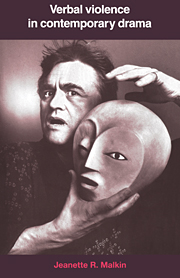5 - Wrestling with language: “head to head”
Published online by Cambridge University Press: 26 February 2010
Summary
Edward Albee's Who's Afraid of Virginia Woolf? and Sam Shepard's The Tooth of Crime are examples of plays in which language is wielded between two combatants as a tool and weapon: language with the power to destroy but also to create, to reinvent. These two very different plays focus on language as interaction, on style as identity. Language is both reduced to a face-to-face battle “to the death” and expanded into an act of creativity and self assertion. In both plays relationships are developed not through, but within language, and verbal mastery is equated – through metaphor and theatrical image – with physical prowess. Characters and authors are very conscious of the words they use, and they wield to win.
Albee's George and Martha are unusually language-conscious – unusually, that is, for a realistic dramatic couple. They obsessively discuss their words, bicker over their verbal styles, win or lose at language-games as though these were concrete realities. Their communication system is to a great degree dependent on verbal imagination and a lust for verbal control. This verbal activity climaxes with the revelation that their son, the object of so much of their verbal aggression, is himself only an invention who is given life, fleshed out and brought up, within language. Albee's insistently vituperative play displays verbal vindictiveness which is first and foremost of the surface. John Gassner and John Mason Brown nominated the play for the Pulitzer Prize in 1962, and when the advisory board rejected their recommendation for this “filthy play,” both Gassner and Brown resigned their positions as members of the Pulitzer Jury.
- Type
- Chapter
- Information
- Verbal Violence in Contemporary DramaFrom Handke to Shepard, pp. 162 - 223Publisher: Cambridge University PressPrint publication year: 1992

